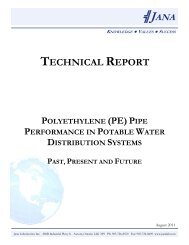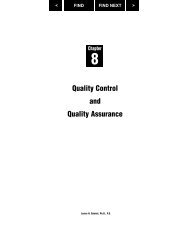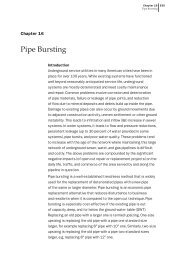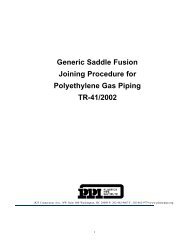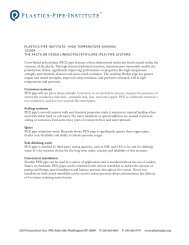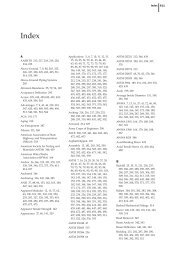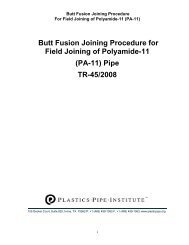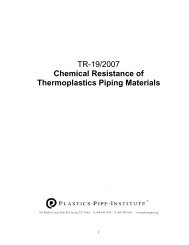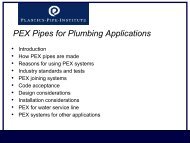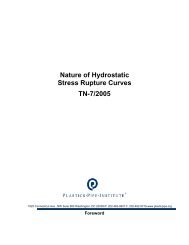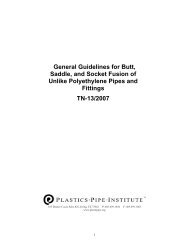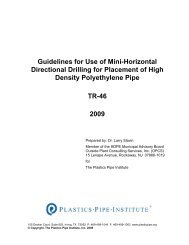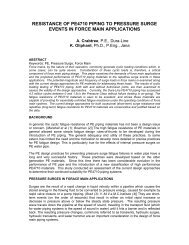TR-2 PPI PVC Range Composition Listing of Qualified Ingredients
TR-2 PPI PVC Range Composition Listing of Qualified Ingredients
TR-2 PPI PVC Range Composition Listing of Qualified Ingredients
You also want an ePaper? Increase the reach of your titles
YUMPU automatically turns print PDFs into web optimized ePapers that Google loves.
fixed amount but rather, by a minimum/maximum range. The acceptable ranges <strong>of</strong> ingredient<br />
content had also to be established by long-term data documentation.<br />
To make it possible to use resins and other ingredients from different suppliers, extruders <strong>of</strong><br />
<strong>PVC</strong> pipe had to qualify a number <strong>of</strong> “different” range <strong>PVC</strong> compositions – each provided by a<br />
different resin supplier – which in fact were <strong>of</strong>ten times quite the same except for source <strong>of</strong><br />
resin, or some other key ingredient. For a manufacturer <strong>of</strong> a new ingredient, or <strong>of</strong> an<br />
alternative to an existing ingredient, having to qualify his product for inclusion in the many<br />
private <strong>PVC</strong> range compositions that then abounded was a costly and time consuming process.<br />
In recognition <strong>of</strong> this situation, the HSB proposed in 1983 to establish a single, generic and<br />
public <strong>PVC</strong> range composition which then included all <strong>PVC</strong> resins and ingredients which had<br />
been qualified in privately held compositions <strong>of</strong> the same kind. To accomplish this required the<br />
cooperation <strong>of</strong> all major holders <strong>of</strong> <strong>PVC</strong> compositions, including their willingness to share with<br />
the HSB their confidential recipes. This cooperation was obtained, the compositions <strong>of</strong> the<br />
many stress-rated compositions were compared, and a single, generic, state-<strong>of</strong>-the-art<br />
composition was established which allowed a wide choice in <strong>PVC</strong> resins and in ingredients.<br />
The HSB next worked on defining the policies and procedures for qualifying new ingredients.<br />
In 1985 the <strong>PPI</strong> <strong>PVC</strong> range composition and related policies were agreed upon and are<br />
published in this report. Since that time many new alternate ingredients have been qualified for<br />
use in this composition.<br />
The policies and procedures in this Technical Report are intended to cover ingredient listings<br />
for most <strong>PVC</strong> piping applications. <strong>PPI</strong> recognizes there may be unusual cases, issues or<br />
circumstances that are not covered in <strong>TR</strong>-2, and that may justify an exception to the standard<br />
policies. To allow manufacturers an opportunity to have their ingredient(s) listed by <strong>PPI</strong> when<br />
this occurs, the HSB has provided a “Special Case” system. The manufacturer may present its<br />
“Case” to the HSB at one <strong>of</strong> their two annual meetings, usually in February and August, using<br />
the approved “Special Case” form in <strong>TR</strong>-3. All information provided to HSB in these special<br />
cases will be made available for review only by HSB members and <strong>PPI</strong> staff, and will be held by<br />
them in strict confidence, in accordance with <strong>PPI</strong>’s written confidentiality procedures (available<br />
from the HSB Chairman). There is a <strong>PPI</strong> fee for each special case. You must contact the HSB<br />
Chairman well in advance <strong>of</strong> each meeting to arrange for your special case. A completed HSB<br />
submission form must be received at least two (2) weeks prior to the HSB meeting to permit<br />
HSB consideration at that meeting.<br />
Page 5




